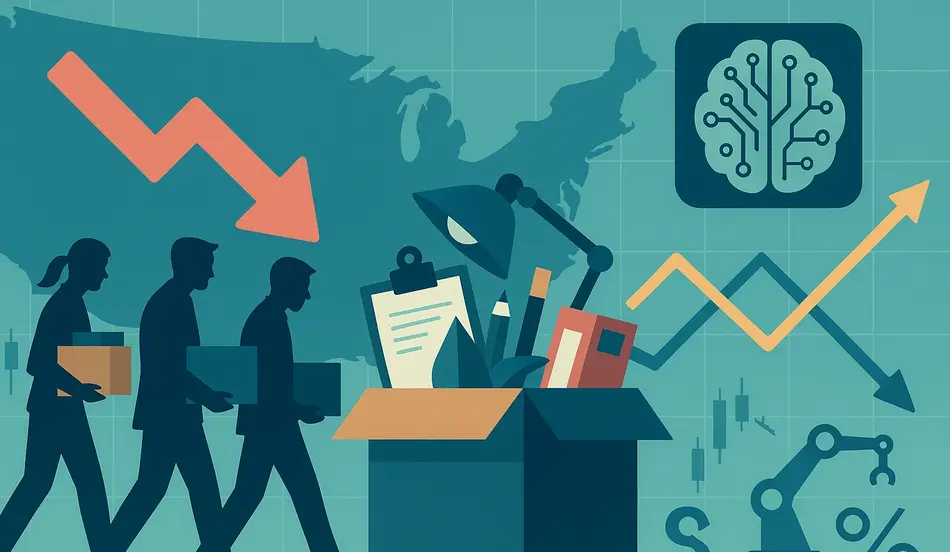The United States is now experiencing the highest number of layoffs since the early months of the COVID-19 pandemic — a troubling sign that the labor market may be weaker than headline numbers suggest.
While official statements and upbeat economic reports highlight a strong job market, many job seekers are telling a different story. According to recent data, one in five unemployed Americans had to submit more than 100 applications to secure just one position — a success rate of less than 1%.
By the end of July 2025, the U.S. had recorded more than 806,000 layoffs, marking a 75% year-over-year jump for the month. The pace has already pushed layoff totals 6% higher than all of 2024, despite five months left in the year.
Small Businesses Hit the Hardest
While layoffs at household names like Amazon, Microsoft, and Target dominate headlines, the deeper pain is often felt at small and mid-sized companies — those with fewer than 50 employees. These firms face higher operating costs due to tariffs, shrinking consumer spending power, and rising wage demands.
Unlike large corporations that can absorb shocks, smaller businesses have less financial cushion. Many attempt to pass costs onto customers through gradual price increases. But when buyers push back, sales drop, forcing companies to cut staff or close entirely.
The AI Dilemma: Job Losses vs. Business Survival
To survive, many businesses are turning to automation and artificial intelligence. This shift is particularly visible in service industries, such as movie theaters, retail, and restaurants, where labor costs are significant.
One example: a movie theater in Idaho now operates with minimal staff. Ticket purchases, ID checks for age-restricted films, and candy sales are handled almost entirely by machines. Human employees are now mostly responsible for pouring drinks and serving popcorn.
Supporters argue that automation reduces the scale of layoffs. Instead of closing multiple stores — and eliminating dozens of jobs — businesses can cut two or three positions per location while keeping doors open. Critics counter that the transition isn’t always so simple and may erode service quality.
Legislation and Pushback
Not everyone is embracing this shift. Rhode Island lawmakers are considering legislation to limit self-checkout lanes at grocery stores, tying their number to how many staffed registers a store maintains. Supporters of such measures argue that widespread automation displaces workers, particularly in low-wage, entry-level jobs.
Opponents say that restricting automation will hurt business competitiveness and may lead to even greater layoffs if companies can’t control costs.
U.S. Layoffs Surge in 2025
AI-driven workplace shifts are reshaping the job market nationwide
Post a Job Now →Why You’re Not Hearing About Many Layoffs
Despite the growing number of job losses, the news cycle rarely focuses on smaller-scale cuts. Local businesses letting go of a handful of workers won’t generate the same attention as mass layoffs at Fortune 500 companies.
This creates a perception gap — with the public largely unaware of the cumulative toll small business downsizing is taking on local economies.
A Slow-Burning Labor Market Shift
The current wave of layoffs is part of a broader transformation in the American workplace. Companies are adapting to higher costs, evolving consumer habits, and the competitive need for technological efficiency. AI and automation are no longer fringe experiments — they are becoming core operational tools.
The question facing both employers and policymakers is no longer whether automation will reshape the workforce, but how quickly — and with what safeguards for displaced workers.
FAQs
1. How many layoffs has the U.S. seen in 2025 so far?
By the end of July, over 806,000 layoffs were reported nationwide, marking a 75% increase compared to July 2024. This figure is already 6% higher than the total layoffs recorded for all of 2024.
2. Why are small businesses laying off more workers than large corporations?
Small firms have less financial flexibility to absorb rising costs from tariffs, wages, and inflation. When consumer spending drops, these businesses are forced to either close locations or cut staff to stay afloat.
3. Is AI really replacing jobs or just helping businesses survive?
Both. Automation can reduce the need for human labor, but in some cases, it allows businesses to operate more efficiently and avoid shutting down entirely. This can result in fewer overall layoffs compared to full closures.
4. Why aren’t these layoffs making national headlines?
Layoffs at small companies often involve fewer workers and occur in scattered locations, making them less newsworthy than mass layoffs at major corporations. However, the cumulative effect on the economy is significant.




